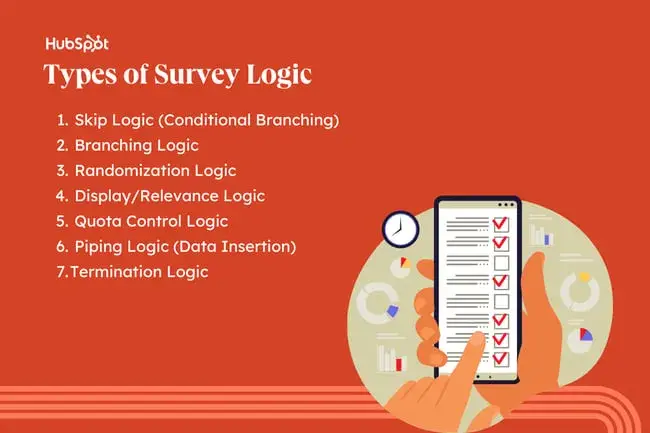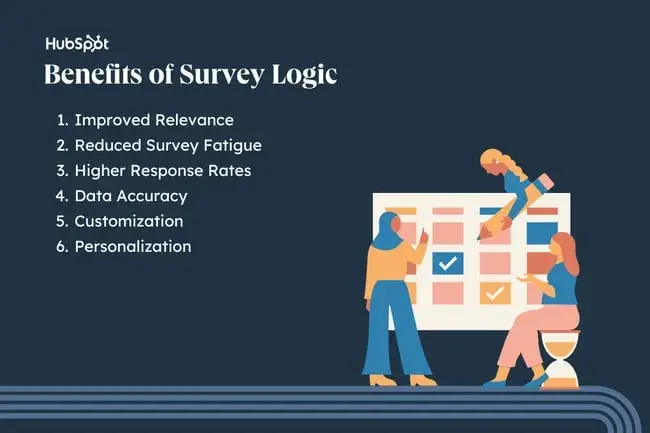Savvy teams use survey logic to adjust questions based on how respondents answer. In this article, let’s explore the basics of survey logic and the different types of logic that make surveys smarter and more engaging.
Table of Contents
What is survey logic?
Survey logic is a feature where surveys adapt to a respondent’s behavior. The order of pages may change. The question order may shift, and notifications may appear. The goal is to create a survey with a logical order, improving the experience and the quality of responses.
“I see survey logic as a tool that transforms a list of generic questions into an engaging and relevant conversation,” says Eylül Nowakowska Beyazıt, director of customer success at surveying company Survicate. “It allows us to ask the right questions to the right people.”
Survey logic improves the quality of data that is collected by ensuring respondents are only asked relevant questions. This leads to surveys with improved response rates and data accuracy, making results more actionable for businesses and researchers.
Here’s an example of survey logic in action:
Think of your survey as an engaging chat versus an interrogation. “In our day-to-day interactions, we adapt our questions based on the behavior of who we’re talking to. Survey logic empowers us to do just that,” Beyazıt says.
Now that we know what exactly survey logic is, we can explore the different types of survey logic.
Types of Survey Logic

1. Skip Logic (Conditional Branching)
Think of your survey like a branching tree. Certain responses lead to more relevant questions. Less relevant queries are tossed out. Survey logic can help you create these branching paths in your surveys.
A respondent’s survey direction depends on their answers to specific questions. This ensures that respondents are only asked questions that are relevant to them.
Keep in mind that skip logic can only move respondents ahead in the survey. Only future questions are altered based on responses.
2. Branching Logic
Branching logic is a more generalized term that encompasses various ways to route respondents through a survey. Skip logic is one specific form of branching, but branching logic can also include directing respondents to different paths based on their demographics, preferences, or other criteria.
Here is a link to Anna Szabo’s tutorial on how she created a Salesforce survey with survey logic. She explains in depth how she used branching logic o her advantage.

3. Randomization Logic
I’ve definitely taken surveys where I could predict the next question before even reading it. That’s where randomization logic comes in. It mixes up the order of questions or answer choices to keep things fresh for each respondent.
This not only makes the survey feel less predictable but also helps remove biases that come from seeing options in a set order. In my opinion, it’s a great way to get more honest and thoughtful responses since people aren’t just picking the first option out of habit.
4. Display/Relevance Logic
Display logic helps you show additional questions or information based on a respondent’s answer. For instance, if a customer expresses interest in lip gloss, the survey might display more detailed questions about the kind of lip gloss they like.
Jeff Sirkin, founder of Sirkin Research, refers to the importance of screener questions.
“We always need to make sure that we’re using screener questions... So it’s not just a single question about your title or your role,” he says. “We want to make sure that it’s very specific to what it is that the survey is about.”
5. Quota Control Logic
As a survey creator, you can use quota control logic to set quotas or limits for specific groups of respondents. Once a quota is met, the survey is closed for that particular group.
For example, let’s say I have a product that appeals to both young parents and college students. I may have more than enough responses from parents. If another parent takes the survey, they’ll receive a notification that ends the process sooner. I can then focus on gathering data from college students.
6. Piping Logic (Data Insertion)
I love when a survey feels like it’s actually speaking to me rather than just running through a list of questions. This advanced survey feature personalizes the experience by reusing respondents’ answers in later questions.
For example, if someone enters their name as “Erica,” the survey can greet them with “Hello, Erica!” This makes the experience more engaging because it feels like a real conversation. In my opinion, small details like this can make a big difference in keeping people interested and willing to complete the survey.
7. Termination Logic
Termination logic helps you determine when a respondent wants to exit the survey. For example, if a respondent selects “I do not wish to continue” or provides certain disqualifying responses, the survey can be set to end.
These different types of survey logic can be combined and applied to create complex survey designs. This allows you to tailor the experience to your specific research objectives and the characteristics of your respondents.
Personally, I also love how this feature allows me to respect the respondent’s time and decision, preventing them from feeling stuck in a survey they don’t want to complete.
Properly implemented survey logic ensures that respondents have a more engaging and relevant survey experience while creators collect accurate and meaningful data.
So, survey logic is not just a “nice to have” if you want to create effective surveys.
Survey Logic Rules
Why do you need survey logic rules? First, they make surveys more efficient by guiding respondents to relevant questions based on their answers. Second, they create a more personalized experience, ensuring participants only see questions that apply to them.
Each rule consists of two key elements:
- Criteria — the condition that must be met, for example, a specific response to a question.
- Action — what happens when the criteria are met, like showing a follow-up question or skipping to a different section.
You can set up rules using:
- Single-question branching. A rule based on just one question. For example, if a respondent answers “Yes” to “Do you own a car?”, a follow-up question about car brands appears.
- Multi-question branching. A rule that considers multiple criteria. For example, if someone selects “Yes” for “Do you own a car?” AND “Electric” for “What type of car do you own?”, they get a question about EV charging habits.
You can mix and match multiple criteria using AND/OR logic:
- AND means all conditions must be met. For example, if a respondent is between 25-35 years old AND selects “Frequent traveler,” they see a question about travel preferences.
- OR means any one of the conditions can trigger the action. For example, if they select “Business traveler” OR “Frequent traveler,” they get the same follow-up question.
Once your criteria are met, you can apply different actions to guide respondents through the survey smoothly.
1. Display a question.
This survey logic rule shows a follow-up question only if it’s relevant to the respondent. Let’s say I’m sending a survey for a line of products, including options for pets. If a respondent selects “Yes” to “Do you have pets?”, they’ll see “What type of pet do you have?” instead of unrelated questions.
2. Skip to a new page.
This rule directs respondents to a specific section based on their answers. For example, if a user selects “Beginner” in a tech skills survey, they skip past advanced-level questions and go straight to beginner-friendly ones.
Pro tip: Avoid sending users back to a previous page, as it can create loops that prevent them from completing the survey.
3. End the survey and show a thank-you page.
Here, the survey ends early and shows a customized thank-you message, if relevant.
If a respondent doesn’t qualify for a study (e.g., selects “No” for “Do you work in the tech industry?”), they see a message like, “Thank you for your time! Unfortunately, this survey is for tech professionals.”
4. End the survey and redirect to a URL.
With this rule, the respondent is sent to a specific website when the survey ends. A survey panel company might redirect disqualified respondents to another available survey that better fits their profile.
Survey Logic Triggers
Survey logic triggers are the criteria that activate specific actions and trigger certain rules in a survey.
Let’s assume that I’m running an employee satisfaction survey. My goal is to follow up with respondents differently, depending on their feedback. I am particularly interested in learning about the reasons why some employees might rate their job satisfaction as “Low.” I’m using a scale of 1-5, where “1” and “2” answers are the lowest scores.
So, I create triggers for these “1” and “2” replies, and display a follow-up question, “Can you share what aspects of your job contribute to your dissatisfaction?” I also set up an automatic notification to HR any time a respondent replies with a low score, so that they can follow up proactively.
Survey logic triggers make surveys “smarter” and more insightful, by adjusting the experience based on how people respond. They focus on each individual case and make sure you don’t deter people’s attention.
For example, the survey might show or hide certain questions and close once enough responses are collected. The survey can even send notifications when a key response comes in. These triggers help keep surveys both relevant to you as someone who runs them and more engaging for respondents.
Benefits of Survey Logic
Survey logic plays a valuable role when designing surveys. Here are some key benefits of using survey logic.

1. Improved Relevance
Survey logic helps you give your responders relevant questions to make the experience, well, logical.
Imagine filling out a feedback form for a retail store. You are asked, “Have you tried our new range of denim shorts?” You reply, “No.” How would you feel if the next question was, “How would you rate the quality of our new range of denim shorts?”
That would be annoying, right?
Survey logic removes this pain point for your participants. The fewer pain points there are, the more accurate data you’ll receive.
2. Reduced Survey Fatigue
Long, complicated surveys bore respondents, and when that happens, they leave. In fact, here’s a scary stat: One in five customers will stop doing business with a company if its surveys are too long.
That’s where survey logic comes in. Showing or skipping questions based on previous answers helps create shorter, more focused surveys. The result? A better experience for your customers and higher completion rates for you.
3. Higher Response Rates
Online surveys often have a wide range of response rates, from as low as 2% to as high as 30%. It largely depends on how you draw the sample and how you recruit participants.
Response rates tend to be higher when participants have a vested interest in the topic. Survey logic can help with this by personalizing the experience, tailoring questions based on previous answers, skipping irrelevant sections, or directing respondents to the most relevant content.
This makes participants more likely to complete the survey, boosting response rates.
4. Data Accuracy
By asking only relevant questions to each respondent, survey logic helps ensure that data is accurate and meaningful. When you use survey logic effectively, you collect cleaner and more structured data. This makes it easier to analyze, draw insights, and make informed decisions.
5. Customization
Survey logic enables you to customize the survey experience. You can create personalized paths for different segments of your audience, ensuring each group is asked questions that address their unique perspectives.
For example, let’s say you want to carry out an employee engagement survey. However, not all employees are the same. You may want to customize your survey for different segments of employees based on their roles, locations, departments, or other criteria.
And guess what? Personalizing web surveys can boost response rates by 8.6% — that’s pretty impressive.
How do you do that effectively and efficiently? Yes, you got it right, through survey logic!
6. Personalization
Survey logic helps personalize surveys by using respondents’ names or tailoring follow-up questions based on their answers. This kind of customization makes a big impact — 80% of consumers are more likely to make a purchase when brands offer personalized experiences.
A more personal approach doesn’t just boost engagement; it also leads to higher-quality responses and more valuable feedback for your brand.
With HubSpot’s customer feedback software, you can easily create custom surveys that capture meaningful insights. Choose from various question types, use flexible templates, and send surveys via web link or email. Then, seamlessly share findings with your team to strengthen customer relationships and improve retention.
Now, let’s explore best practices for using survey logic.
Survey Logic Best Practices
Here’s what Beyazıt of Survicate had to say about using survey logic:
“If used correctly, survey logic can help you transition from gathering feedback to taking action by seizing the power of the moment. It helps you craft surveys that … create dynamic conversations tailored to each respondent’s unique perspective.”
Looking to unlock the power of survey logic? Here are the best practices and expert tips to help you get it right.

1. Plan your survey carefully.
Before implementing survey logic, have a clear understanding of your research objectives and the specific data that you need to collect. Plan your survey questions, logic, and branching paths accordingly.
2. Keep it simple.
While survey logic can be powerful, avoid overcomplicating your survey. Excessive branching or complex skip patterns can confuse respondents. Try to make your surveys simple and clear.
“I once worked with this online shop, and they got so wrapped up in creating the ‘perfect’ survey that they ended up leaving out a chunk of their customers,” says Sudhir Khatwani, founder at The Money Mongers. “It just goes to show, sometimes you can overthink things and end up missing the forest for the trees.”
Pro tip: Don’t add hide-and-skip logic functions together. Skip logic is used to skip questions based on respondent choices. Hide logic removes questions that may or may not be relevant based on the specific responses. Using both of them in one survey could result in a disorderly flow of questions.
3. Test your survey.
Always thoroughly test your survey with a small group of participants before launching it to a larger audience. This helps you identify any issues with the logic, wording, or flow of questions.
Be sure that your survey settings work the way you want and that your questions are not biased, leading, or confusing.
4. Don’t overwhelm respondents.
A long list of questions can leave your respondents overwhelmed. This is especially true if your survey involves several branching logical conditions. Use more pages and spread out information, instead of cramming everything on one page.
“One question per page keeps the flow going; stacked questions on the same page can feel overwhelming,” says Maya Kislykh, head of content at Bluestone PIM.
Page number aside, however, I’m sure you’re wondering — what’s the ideal number of questions? According to 42% of respondents in a HubSpot survey, there should be anywhere between 7 and 10 questions.
5. Consider mobile responsiveness.
More and more people access the internet on their smartphones. This means your survey must be responsive so it looks great (and includes your intended survey logic) on all devices. Test the survey on various devices and browsers to ensure compatibility.
I recommend choosing a survey creation software that has mobile design basked in. Looking for a place to start? Hubspot’s survey tool can help.
6. Monitor survey progress.
While you are collecting data, I recommend monitoring your survey progress and completion rates. If you notice a high dropout rate at a particular question or section, investigate the reason why. It’s possible that the survey logic is causing confusion or frustration.
Regularly check the survey data to verify that the logic is functioning as intended and that the collected data is accurate and complete.
7. End your survey right.
How you conclude your survey is just as important as the questions you ask throughout. If your respondent makes it all the way to the end, you can gather more information to follow up later.
“[You can] add an email gate on the final question page, as participants are typically more engaged at that stage and more likely to provide their contact details,” says Kislykh.
For those who don’t want to complete the survey, you can let them go. Always include an option for respondents to exit the survey at any point if they choose to do so. I find this respects their autonomy and prevents complaints.
The Future of Survey Logic
Today, we have surveys that adapt to respondent behaviors. These conditional elements already surface better insights and lead to higher completion rates. So what’s next?
“If you ask me where surveys are headed… Well, I reckon we’re on the brink of some cool stuff,” Khatwani says. “Imagine a survey that adjusts in real time, tapping into past data and predicting the best next question. That’s the future, and I’m here for it.”
Editor's note: This post was originally published in November 2023 and has been updated for comprehensiveness.
Survey Creation
.png?width=112&height=112&name=Image%20Hackathon%20%E2%80%93%20Horizontal%20(24).png)

.webp)
![16 best free online survey makers and tools [+ recommendations]](https://53.fs1.hubspotusercontent-na1.net/hubfs/53/free-online-survey-maker-1-20251028-2654831.webp)


![How to conduct survey analysis like a data pro [all my tips + secrets]](https://53.fs1.hubspotusercontent-na1.net/hubfs/53/survey-results-1-20241031-6355381.webp)
![Leading questions: What they are & why they matter [+ Examples]](https://53.fs1.hubspotusercontent-na1.net/hubfs/53/leading-questions-hero.webp)
![How long should a survey be? The ideal survey length [New data]](https://53.fs1.hubspotusercontent-na1.net/hubfs/53/how%20long%20should%20a%20survey%20be_featured.png)



![What Is a Likert Scale? [Examples & Templates]](https://53.fs1.hubspotusercontent-na1.net/hubfs/53/likert-scale-1-20241031-1487623.webp)